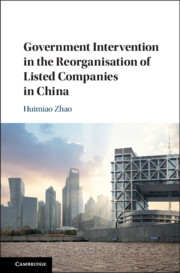Book contents
- Government Intervention in the Reorganisation of Listed Companies in China
- Government Intervention in the Reorganisation of Listed Companies in China
- Copyright page
- Dedication
- Contents
- Figures
- Tables
- Acknowledgements
- Abbreviations
- Reviews
- 1 Introduction to the Research
- 2 The Legislative Goals of the Enterprise Bankruptcy Law of the PRC
- 3 The Role of the Government in the 1986 EBL and 2006 EBL
- 4 Administrative Goals and Means of Government Intervention
- 5 Negative Impacts Exerted by Government Intervention on Bankruptcy Institutions
- 6 Balancing the Roles of Different Institutions for the Future Reform of China’s Bankruptcy Market
- Conclusion
- Appendices
- Bibliography
- Index
3 - The Role of the Government in the 1986 EBL and 2006 EBL
Published online by Cambridge University Press: 20 December 2019
- Government Intervention in the Reorganisation of Listed Companies in China
- Government Intervention in the Reorganisation of Listed Companies in China
- Copyright page
- Dedication
- Contents
- Figures
- Tables
- Acknowledgements
- Abbreviations
- Reviews
- 1 Introduction to the Research
- 2 The Legislative Goals of the Enterprise Bankruptcy Law of the PRC
- 3 The Role of the Government in the 1986 EBL and 2006 EBL
- 4 Administrative Goals and Means of Government Intervention
- 5 Negative Impacts Exerted by Government Intervention on Bankruptcy Institutions
- 6 Balancing the Roles of Different Institutions for the Future Reform of China’s Bankruptcy Market
- Conclusion
- Appendices
- Bibliography
- Index
Summary
This chapter compares the government powers in the 1986 and 2006 EBLs and explores the reasons that have led to government intervention in enterprise bankruptcies. The government intervention in the 1986 EBL can be attributed to its inappropriate goals (the mixture of administrative goals with bankruptcy goals) and Chinese lawmakers’ misunderstanding of its nature and goals as is discussed in Chapter 2. The 2006 EBL, however, successfully detaches the bankruptcy goals from the administrative goals because of the change of economic strategy, construction of supporting institutions, and the legal and institutional development concerning listed companies. The 2006 EBL becomes a bankruptcy law in a real sense, addressing the debt problems between the debtor and its creditors. The role of the government has been greatly constrained in the legal text of the 2006 EBL. The government, however, may not give up its powers easily. The governments try all means to avoid delisting and liquidating listed companies, in order to maintain a strong public sector and protect local interests associated with the listed companies. It is still necessary to examine the administrative goals of the government and its means of intervening in the bankruptcy process of listed companies.
Keywords
- Type
- Chapter
- Information
- Publisher: Cambridge University PressPrint publication year: 2020



